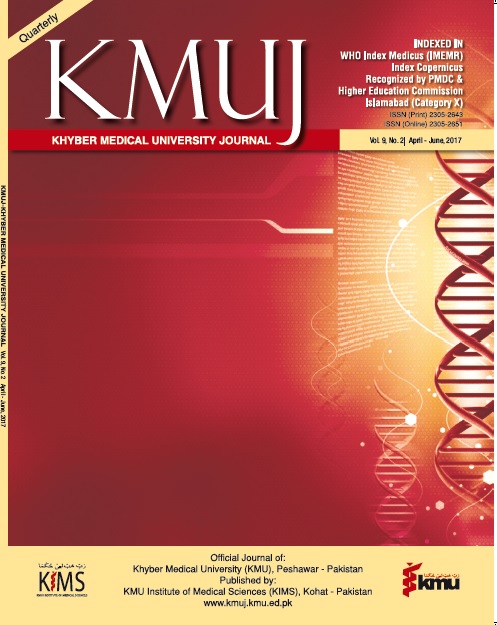ST ELEVATION MYOCARDIAL INFARCTION: AN EXPERIENCE AT LADY READING HOSPITAL PESHAWAR, PAKISTAN
Main Article Content
Abstract
ABSTRACT
OBJECTIVE: To find out the clinical characteristics, treatment offered and outcome of patients with ST elevation myocardial infarction (STEMI) admitted to cardiology unit Lady Reading Hospital (LRH), Peshawar, Pakistan.
METHODS: This retrospective observational study was conducted in Cardiology Unit, LRH, Peshawar, Pakistan by analyzing record of all diagnosed STEMI patients of age >18 years, from 1st January to 31 December 2013.
RESULTS: Total number of patients admitted with STEMI were 1733 (46.02% of total coronary artery disease admission). Of all these patients with STEMI, fibrinolytic therapy with streptokinase were given to 1380 (79.6%) patients, while 343 (19.8%) were late for fibrinolytic therapy or having some contraindication to fibrinolytic therapy. Ninety four (5.4%) patients received primary or rescue percutaneous coronary intervention (PCI). Out of 1733 patients, males were 1085 (62.60%), female were 648 (37.40%), mean age was 57.42±8.7 years, diabetes was found in 458 (26.39%) cases, hypertension in 679 (39.18%) cases, smokers were 183 (10.5%). Family history of coronary artery disease (CAD) was found in 205 (11.82%) cases, past history for CAD was present in 305 (17.5%) patients and anterior wall myocardial Infarction & new onset left bundle branch block was found in 790 (45%) cases. In-hospital mortality was 158 (9.1%).
CONCLUSION: About 46% of patients admitted with CAD were having STEMI, of them 80% receive streptokinase while only 5.4% were subjected to primary or rescue PCI. In-hospital mortality is about 9%. Anterior wall MI was the most frequent AMI.
KEY WORDS: Coronary Artery Disease (MeSH), Streptokinase (MeSH), Myocardial Infarction (MeSH), Percutaneous Coronary Intervention (MeSH), Hospital Mortality (MeSH), Thrombolytic Therapy (MeSH)
Article Details
Work published in KMUJ is licensed under a
Creative Commons Attribution-NonCommercial 2.0 Generic License.
Authors are permitted and encouraged to post their work online (e.g., in institutional repositories or on their website) prior to and during the submission process, as it can lead to productive exchanges, as well as earlier and greater citation of published work.
(e.g., in institutional repositories or on their website) prior to and during the submission process, as it can lead to productive exchanges, as well as earlier and greater citation of published work.
References
REFERENCES:
Hampton J, Gray A. The future of General Medicine; Lesson from an admission ward. J Roy Coll Physcian 1998;32:39-43
Gupta M, Singh N, Verma S. South Asians and cardiovascular risk: what clinicians should know? Circulation 2006; 113: e924-9.
Jafar TH, Jafary FH, Jessani S, Chaturvedi N. Heart disease epidemic in Pakistan: women and men at equal risk. Am Heart J 2005;150:221-6.
Rogers WJ, Canto JG, Lambrew CT, Tiefenbrunn LJ, Kinkaid B, Shoultz DA, et al. Temporal trends in the treatment of over 1.5 million patients with myocardial infarction in the US from 1990 through 1999: the National Registry of Myocardial Infarction 1, 2 and 3. J Am Coll Cardiol 2000; 36: 2056–63.
American Heart Association. Heart Disease and Stroke Statistics 2004 Update. Dallas, TX: American Heart Association 2003.
Wiviott SD, Morrow DA, Giugliano RP. Performance of the thrombolysis in myocardial infarction risk index for early acute coronary syndrome in the National Registry of Myocardial Infarction: a simple risk index predicts mortality in both ST and non-ST elevation myocardial infarction. J Am Coll Cardiol 2003; 41: 365A–366A.
Thomas JL1, French WJ2. Current State of ST-Segment Myocardial Infarction: Evidence-based Therapies and Optimal Patient Outcomes in Advanced Systems of Care. Cardiol Clin 2014;32(3):371-385.
Arshad S, Dhakam S, Awan S. Outcomes in ST elevation Myocardial Infarction; a comparison of a tertiary care center in Pakistan with European centers. Journal of the Pakistan Medical Association 2011, 61(12), 1215-9.
Eurobservational Research programme Acute Coronary Syndrome Registry 2010. (Online) (Cited 2010 December 21). Available from UR: https://www.euroheartsurvey.org/.
Xavier D, Pais P, Devereaux PJ, Xie C, Prabhakaran D, Reddy KS, et al. Treatment and outcomes of acute coronary syndromes in India (CREATE): a prospective analysis of registry data. Lancet 2008; 371:1435-42.
Jafary FH, Arham AZ, Waqar F, Raza A, Ahmed H. Survival of patients receiving fibrinolytic therapy for acute ST-segment elevation myocardial infarction in a developing country - patient characteristics and predictors of mortality. J Thromb Thrombolysis 2008;26:147-9.
Jafary FH, Ahmed H, Kiani J. Outcomes of primary percutaneous coronary intervention at a joint commission international accredited hospital in a developing country -- can good results, possibly similar to the west, be achieved? J Invasive Cardiol 2007; 19: 417-23.

